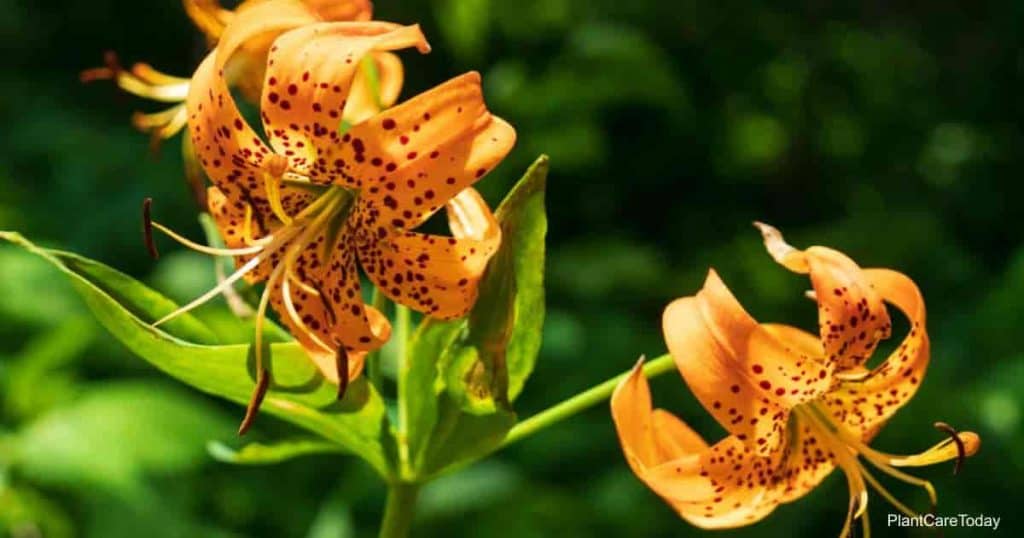Turk’s cap lily, is known by its scientific name as Lilium Superbum (LIL-ee-um, soo-PER-bum), of the Liliaceae or lily family. It is a native lily from the central and eastern regions of North America.
This is a tall, flowering plant widely distributed in wet meadows of new Hampshire, New York, Illinois, Arkansas, Missouri, Alabama, Georgia, Florida, and many other states in the United States.

A few common names of Turk’s cap lilies are as follows:
- American Tiger Lily
- Turban Lily
- Swamp Lily
- Lily Royal
- American Tiger Lily
- Martagon Lily
Turk’s Cap Lily Care
Size and Growth
Lilium superbum is the tallest American native lily, typically reaching up to 4’ – 6’ feet tall and spreading up to 0.50’ – 0.75’ feet.
The attractive plant features elliptic leaves arranged in whorls along the stems.
These green leaves increase up to 6” inches long in a pattern of unique spirals.
Flowering and Fragrance
Turk’s cap lilies produce vivid orange wildflowers filled with seedpods, extending up to 2.5” – 4” inches wide.
The green streak at the center of each flower petal forms a green star in the center.
The unique orange flowers have green throats hinted with intense maroon spots.
The flower faces downward with reflexed sepals and petals curved backward, touching at the stem and thus resembling a “Turk’s cap”.
It has been recorded that the largest of the native lilies has produced 40 flowers on a single plant.
The bloom time of these gorgeous flowers is usually from early to mid-summer, where they appear in inflorescences along the stems.
Unlike a typical lily, American tiger lilies have no noticeable floral scent.
More on Tiger Lily Bulbs:
Light and Temperature
Turk’s cap lilies prefer full sun or part shade for healthy development.
These beautiful lilies require 16 hours of light, at a minimum.
In winter, the flowering plant may need artificial lighting for up to 6000 lux.
When young and growing, the plant needs to be placed in a greenhouse, at the temperature of 50° to 64° degrees Fahrenheit (10° – 18° C), to enjoy partial shade or partial sun.
Ensure the soil temperature is approximately 48° degrees Fahrenheit (9° C).
The USDA hardiness zone of the plant is from 3 to 9.
Watering and Feeding
The turk’s cap lily requires light watering to keep the soil moist.
Most plant species prefer an inch of water per week, usually during the growing season.
However, make sure to provide the soil with regular watering in the first two years of the plant.
Frequently fertilize Turk’s cap lilies when they are young and developing.
Apply a good layer of compost at the base of the plant two times a year for necessary plant nutrition.
Adding mulch in the scorching summer helps keep roots cool and hydrated.
To encourage more flowering, apply a 5-10-5 fertilizer to the plant.
Soil and Transplanting
Lilium Gazarubrum prefers moist, well-drained soil for proper growth.
For proper drainage, the soil should contain humus or compost.
Adding sand and peat moss into the soil are also some great ways to regulate drainage and ensure ideal moisture.
Ideally, the clumps of Turk’s cap are transplanted in spring.
When transplanting, lightly prune them from the top and ensure the soil is moist and drained.
Grooming and Maintenance
In late summer, the foliage of the mature plant begins to turn yellow.
Usually, the lower half of the stalks begin to die and then the remaining parts of the plant.
When all the leaves lose their vitality, prune the stalks all the way to their base.
Cut them in the summer or late fall to protect the lily plant from harmful diseases.
If you’re a fan of the Turk’s Cap Lily, you might also enjoy growing the stunning Star Gazer Lily.
How to Propagate Lilium Superbum
Propagation of the plant is ideally done by bulb division, often in spring.
Dig the plant and separate all the bulbs gently.
Replant them in a new pot and ensure the pointy ends are placed upward.
New bulbils will form at the leaf axils of the stem in a year or two.
To prevent the excessive spreading of the lily plant, dispose of the additional bulbil and propagate it into a new pot.
Lilium Superbum Pests and Diseases
Turban lilies are tough plant species and are rarely susceptible to severe diseases.
Lack of care and maintenance may cause the plant to suffer from dangerous virus attacks.
Red lily beetles are extremely harmful to a Turk’s cap plant as they often eat the leaves.
These hideous pests should be eliminated with an appropriate pesticide such Diatomaceous Earth as as soon as possible.
Turk’s Cap Lily Uses
The plant bulbs are recognized for their edible uses.
They typically have a starchy, sweet flavor used for thickening soups.
Turk’s cap lilies offer sweet nectar at the base of the stamens and anthers to pollinators such as butterflies, hummingbirds, and swallowtails.
They are also a good option for meadows, native plant gardens, and cottage gardens.
With their addition, space becomes more beautiful and attractive.